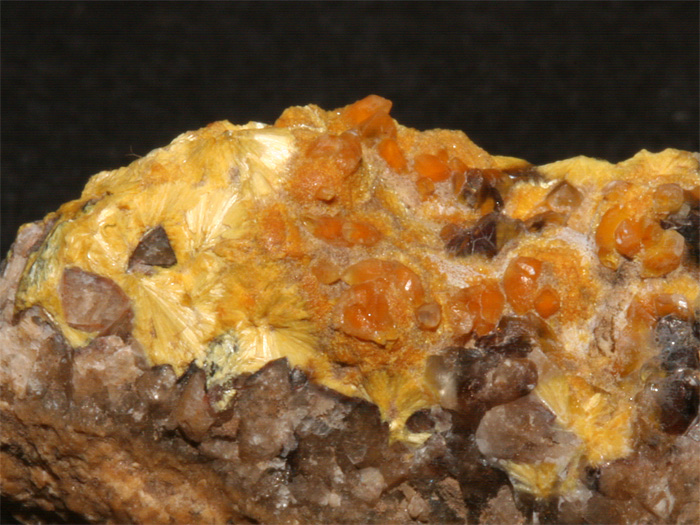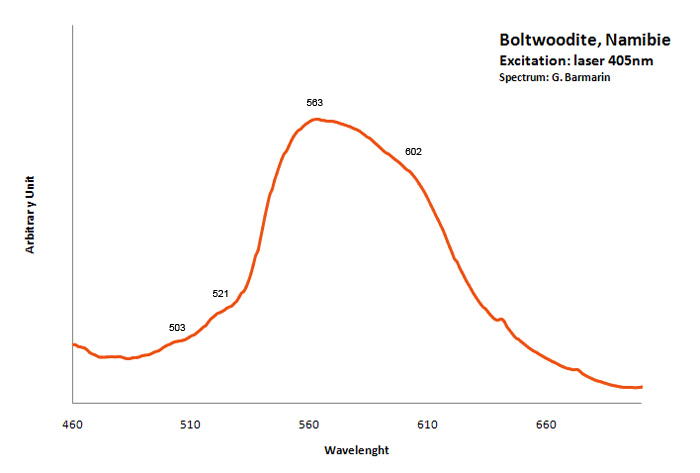Database of luminescent minerals
BOLTWOODITE
Chemical formula: (K,Na)(UO2)(SiO3OH) 1,5H2O
Family: Silicates
Status: IMA-GP
Display mineral: NON
Luminescence:
Longwave UV (365nm) colors: |
Dark Orange /Tawn , Orangy yellow , Orange , Tawn , Greenish , Brownish Green , | ||
Intensity LW:Very weak | Frequency LW:Always | ||
Shortwave UV (254nm) colors: |
Tawn , Greenish , Brownish Green , | ||
Intensity SW:Very weak | Frequency SW:Always | ||
Daylight picture

BOLTWOODITE, Rössing Mine, Namibia;
Col. G.Barmarin; Photo: G. Barmarin
Longwave (365nm) picture

BOLTWOODITE, Rössing Mine, Namibia; UVLW
Col. G.Barmarin; Photo: G. Barmarin
Shortwave (254nm) picture

BOLTWOODITE, Rössing Mine, Namibia; UVSW
Col. G.Barmarin; Photo: G. Barmarin
Pictures Galery:



 ...
...Do you have a photo of this mineral you would like to see in the gallery? Contact us!
Phosphorescence (in the common sense of the term) observable with the naked eye:
No phosphorescence visible to the naked eye under any type of UV
Comments:
Fluoresces dull yellowish-green to brown in both SW and LW UV
Activator(s) and spectrum:
Activator(s): (UO2)2+ (ion Uranyle) intrinsèque ,
Peaks in the spectrum (nm):
470, 500, 520, 545, (555), 565-570 large band around 578nm with events at 503, 521, 563 and 602nm 485.1, 501.5, 521.2, 543.0, 567.4, and 591.4 nm (Thuro Arnold and Nils Baumann)

Col. G. Barmarin; Spectre: G. Barmarin
Comments on spectrum and activators:
Gorobets: 18850 cm-1, 18050 cm-1; fluorescence lifetimes of 382 and 2130 ns (bi-exponential)
Best localities for fluorescence (*):
- Rössing Mine, Arandis, Swakopmund District, Erongo Region, Namibia;
- New Method Mine, San Bernardino County, California, USA (dull green SW associated with fluoborite cream SW);
(*)The data are not exhaustive and are limited to a few remarkable localities for fluorescence
Bibliographic reference for luminescence:
- The Henkel Glossary of Fluorescent Minerals, Dr. Gerhard Henkel, Published by the FMS, 1989 ,
- Fluorescence: Gems and Minerals Under Ultraviolet Light, Manuel Robbins, 1994, Geoscience Press, ISBN 0-945005-13-X ,
- Luminescent Spectra of Minerals, Boris S. Gorobets and Alexandre A. Rogojine, Moscow, 2002 ,
- Uranium minerals Website: http://www.uraniumminerals.com ,
- Introduction to radioactive minerals, Robert Lauf, Schiffer Publishing, 2008, ISBN 978-0-7643-2912-8 ,
Reference for luminescence on the Internet:
- A NEW METHOD OF SYNTHESIS OF BOLTWOODIT AND OF FORMATION OF SODIUM BOLTWOODITE URANOPHANE, SKLODOWSKITE AND KASOLITE FROM BOLTWOODITE, Renaud Vochten, Canadian Mineralogist, Vol. 35, 1997
- Boltwoodite [K(UO2)(SiO3OH)(H2O)1.5] and compreignacite K2[(UO2)3O2(OH)3]2·7H2O characterized by laser fluorescence spectroscopy, Thuro Arnold and Nils Baumann, Spectrochimica Acta Part A: Molecular and Biomolecular Spectroscopy, Volume 71, Issue 5, January 2009, Pages 1964-1968.
- http://www.handbookofmineralogy.com/pdfs/boltwoodite.pdf
Mineralogical reference on the Internet:
 http://www.mindat.org/show.php?name=Boltwoodite
http://www.mindat.org/show.php?name=Boltwoodite
 http://webmineral.com/data/Boltwoodite.shtml
http://webmineral.com/data/Boltwoodite.shtml
Internet Search:
 Image search on 'Google Images'
Image search on 'Google Images'
 Search for documents in all languages on Google
Search for documents in all languages on Google
A request providing no result means only that no such reference exists in the database, but it does not mean that what you are looking for does not exist, just not to our knowledge. If you think you have found an error or omission, please let us know via the contact page being sure to cite the source of information.

